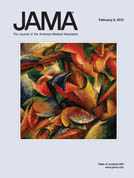AJP:促进乳腺正常功能的TFF3蛋白也促进乳腺癌转移
2012-02-24 Towersimper MedSci原创
基于PDB文件1e9t利用PyMQL构建TFF3蛋白结构图 三叶因子3(trefoil factor 3, TFF3)蛋白在正常乳腺中保护和维持上皮组织表面的完整性。一项新研究发现尽管TFF3蛋白在分化很好的低度肿瘤中较高表达,但是它在乳腺癌浸润和转移中发挥着一种更加险恶的作用。这些研究结果在线发表在2012年3月那期The American Journal of Pathology期刊上。

基于PDB文件1e9t利用PyMQL构建TFF3蛋白结构图
三叶因子3(trefoil factor 3, TFF3)蛋白在正常乳腺中保护和维持上皮组织表面的完整性。一项新研究发现尽管TFF3蛋白在分化很好的低度肿瘤中较高表达,但是它在乳腺癌浸润和转移中发挥着一种更加险恶的作用。这些研究结果在线发表在2012年3月那期The American Journal of Pathology期刊上。
英国纽卡斯尔大学病理学系研究人员Felicity E.B. May教授说,“我们的研究发现提示着TFF3被雌激素所调节和在乳腺上皮组织中发挥着有益作用。我们提出在乳腺癌变早期,TFF3与乳腺上皮细胞的正常功能保持关联。随后,随着肿瘤细胞分化能力丢失,TFF3的功能改为促进肿瘤发展、浸润和淋巴结转移。”
为了确定TFF3在乳腺癌中的作用,研究人员测量了来自正常乳腺、良性乳腺病灶、原位乳腺癌、浸润性乳腺癌和受累淋巴结的组织样品中TFF3的水平。TFF3在研究的大多数良性和恶性的乳腺病灶中都表达。分化很好的肿瘤类型表达更高水平的TFF3。而且TFF3蛋白表达和微血管密度存在显著的正向关联,提示着它在乳腺肿瘤中促进血管生成。
这项研究的一种显著性发现是TFF3表达和浸润性乳腺癌中更具转移性的表型之间关联的紧密性和一致性。TFF3在与肿瘤转移相关联的原发性肿瘤中更加高水平的表达,而且在从原发性肿瘤内迁移出来的恶性癌细胞中更是高水平的表达。
这似乎表明浸润性癌症内TFF3的正常极性分泌过程存在一种开关,它允许浸润性癌症表现出促进浸润的效应。
这项研究提示着TFF3可能是在乳腺癌中介导雌激素不同效应的众多基因之一。May教授注意到,“不过,对雌激素受体和TFF3而言,矛盾一直存在:它们促进乳腺癌上皮组织的正常生理功能,但是也参与癌症扩散。”
重要的是,研究人员也评估了TFF3作为淋巴血管浸润和淋巴结转移的生物标记物的潜力。他们发现相比于他们分析的其他标记物,TFF3有着更强的预测能力,包括肿瘤恶性程度、发病年龄、肿瘤大小和类型以及雌激素和黄体素(progesterone)受体水平。May博士作下结论,“我们的研究加强了这种观点:TFF3表达水平值得作为一种预后标记物和一种治疗反应的预测性标记物进行评价。它的恶性作用将可能在患有激素反应性癌症(hormone-responsive cancer)的女性中通过辅助性内分泌治疗得以减轻。然而,利用TFF3作为一种激素反应性的标记物还需要进行评估。”

doi:10.1016/j.ajpath.2011.11.022
TFF3 Is a Normal Breast Epithelial Protein and Is Associated with Differentiated Phenotype in Early Breast Cancer but Predisposes to Invasion and Metastasis in Advanced Disease
A.R.H. Ahmed, A.B. Griffiths, M.T. Tilby, B.R. Westley, and F.E.B. May
The trefoil protein TFF3 stimulates invasion and angiogenesis in vitro. To determine whether it has a role in breast tumor metastasis and angiogenesis, its levels were measured by immunohistochemistry in breast tissue with a specific monoclonal antibody raised against human TFF3. TFF3 is expressed in normal breast lobules and ducts, at higher levels in areas of fibrocystic change and papillomas, in all benign breast disease lesions, and in 89% of in situ and in 83% of invasive carcinomas. In well-differentiated tumor cells, TFF3 is concentrated at the luminal edge, whereas in poorly differentiated cells polarity is inverted and expression is directed toward the stroma. Expression was high in well-differentiated tumors and was associated significantly with low histological grade and with estrogen and progesterone receptor expression, accordant with induction of TFF3 mRNA by estrogen in breast cancer cells. Paradoxically, TFF3 expression was associated with muscle, neural, and lymphovascular invasion and the presence and number of involved lymph nodes, and it was an independent predictive marker of lymphovascular invasion and lymph node involvement. Consistent with an angiogenic function, TFF3 expression correlated strongly with microvessel density evaluated with CD31 and CD34. In conclusion, TFF3 is expressed in both the normal and diseased breast. Although associated with features of good prognosis, its profile of expression in invasive cancer is consistent with a role in breast tumor progression and tumor cell dissemination.
本网站所有内容来源注明为“梅斯医学”或“MedSci原创”的文字、图片和音视频资料,版权均属于梅斯医学所有。非经授权,任何媒体、网站或个人不得转载,授权转载时须注明来源为“梅斯医学”。其它来源的文章系转载文章,或“梅斯号”自媒体发布的文章,仅系出于传递更多信息之目的,本站仅负责审核内容合规,其内容不代表本站立场,本站不负责内容的准确性和版权。如果存在侵权、或不希望被转载的媒体或个人可与我们联系,我们将立即进行删除处理。
在此留言









#癌转移#
77